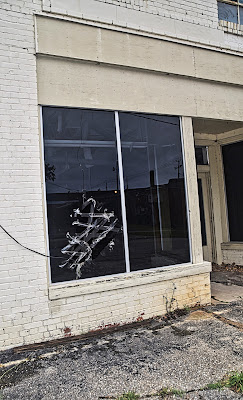McClellanville residents Bud Hill and Billy Baldwin talked about and signed copies of Carolina Rambling, their new book of photographs and poetry at the Williamsburgh Historical Museum last Saturday afternoon. Many of the photographs in the book are of Williamsburg County scenes.
Billy Baldwin (left) and Bud Hill wait for the program to start.
This is the third book Bud, who is director emeritus of the Village Museum in McClellanville, and his cousin Billy, a poet and author with numerous books to his credit, have published together. The first two, The Unpainted South and These Our Offerings, were both Benjamin Franklin Award winners. The Benjamin Franklin Award celebrates excellence in independent publishing.
The books are a result of the two's habit of several days a week heading out on the road, sometimes in a direction they've never been before and sometimes as Bud describes, "Billy will drag me to a place he's written a poem about so that I can take a photo."
Bud Hill recounts an adventure he and Billy Baldwin encountered while gathering material.
Saturday, with much good-natured razzing of each other, they described their adventures, and misadventures, to an appreciative audience. Bud noted that while they are often met with suspicion by people they encounter in their travels, once he explains that he's photographing old landmarks like churches, barns, and general stores, "they are so generous with the history of their communities." Being from McClellanville doesn't hurt, either, as he said people warm up to them when they find out where they're from because "everyone seems to love McClellanville."
The audience listens to Bud Hill recount tales of their travels.
As the two like finding old country stores, churches, tobacco barns and other buildings from the past, it seems particularly fitting that they gave their presentation in a building that had the day before, on June 22, celebrated its 101st birthday.
Kingstree residents met at the Main Street home of Louis Jacobs in May 1900 to discuss establishing a circulating library for the town. They formed the Williamsburg County Library Association which met monthly for awhile but made no real progress toward meeting their goal. Within a few years, with the building of the Kingstree Graded and High School, the push began to establish a good school library, and fundraisers were often held to buy more books for that library.
However, in 1915, citizens circulated a petition, gathering enough signatures to call for a vote on the construction of a public library, the cost not to exceed $7,500 with the town committed to an annual contribution of $750 for its maintenance. Shortly thereafter, Andrew Carnegie's Carnegie Corporation offered $6,000 to the town to build a library if the town would guarantee annual support of $600 and provide a site for the building. In an election, held on June 22, 1915, the referendum to build the library passed by a vote of 50-14.
The State newspaper of June 26, 1915, noted, "The Town of Kingstree owns a beautiful site for the proposed library at the corner of Mill Street and Hampton Avenue, the old public school site, which it is thought will be donated for the library site."
The town opened bids for the project on January 21, 1916, awarding the project to Grandy & Sons of Sumter for a bid amount of $5,150. Grandy & Sons was well-known in town for building the Williamsburg Presbyterian Church and re-modeling the Wee Nee Bank.
The Library Commission and the Civic Club joined forces to form the Civic and Library Commission to oversee the outfitting of the new library. On Friday evening, June 22, 1917, the doors of the library were thrown open for the first time for a grand opening and library "shower." A large number of citizens attended, each bringing a book or set of books to start the library's collection. Local attorney, Capt. John A. Kelley, presented the library with a set of Encyclopedia Britannica. Two large library tables were filled with book offerings before the evening ended. At either end of the library, ladies served punch and cake to the crowd. Agness Erckmann, who had taught first grade in Kingstree for many years, became the new librarian.
At the time of its opening, the upstairs was used as the library, and in February, 1918, the Red Cross opened a work room in the basement. The work room was open Wednesday, Thursday, and Friday of each week for ladies to knit socks and sweaters or to sew pajamas. The sewing machines, tables, and chairs used to outfit the work room were all donated for the Red Cross to use. On April 10, 1918, 25 pairs of knitted socks, 20 sweaters, 72 pairs of bed socks, and 62 pairs of pajamas were shipped from the Kingstree Red Cross work room to help in the war effort.
The building continued to serve as the Williamsburg County Library until 2000 when a new library was built on Jackson Street, and the old library became the home of the Williamsburgh Museum.
One hundred and one years and one day after the library's opening, the board of the Williamsburgh Historical Society also served cake and punch to those attending the book-signing. In closing his remarks, Bud Hill noted that old landmarks like general stores, churches, tobacco barns, and service stations are disappearing at an accelerating rate. People "don't put a lot of value in things not being used anymore," he said. "South Carolina is changing," he added, "and I think it is important for future generations to see what was here."
Kingstree can be thankful that its old library is still lovingly used in the service of reminding all of us of the important ways the past continues to influence the present and shape the future.
Williamsburgh Museum Director Wendell Voiselle will have copies of Carolina Rambling for sale at the museum for anyone who missed the book-signing. The museum's hours are Tuesday, Wednesday, and Thursday from 10 a.m. until 3 p.m.


































